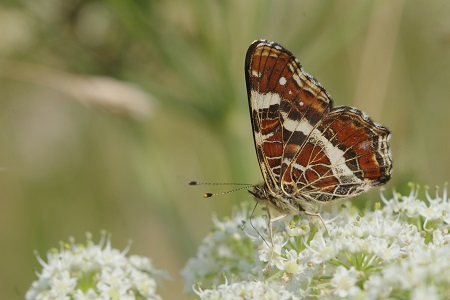| Home
V.V.E. | Dagvlinders | Synopsis | Acknowledgements | Content | General Chapters | Monographs | Appendices | Additions | Sources | Index | |
|
1 Benelux The Benelux is the economic union between Belgium, the Netherlands and Luxemburg, established in 1960. The area of these three countries together measures 66.808 km². This is only 0.6% of the area of the European continent, Nevertheless , 120 butterfly species are recorded here over the last century which is 26% of the total number of European butterfly species. Composition of the butterfly fauna Every country has its own species which were common and widespread in historical times and which are rare today as the result of landscape changes. The species which have disappeared, are often qualified as extinct but they may still occur, even commonly, elsewhere in Europe.
The marbled fritillary (Brenthis daphne) appeared around 2006 in Wallonia and it has been recorded already in the Netherlands in 2011. This species extended its distribution in Wallonia very rapidly: in 2007, the species had been recorded from only three blocks of 5 x 5 km but by 2010 from 26. Table 1-1. Number of recorded species per country in the past and at the present time.
Table 1-2. Diference between Wallonia and Flanders in number of recorder species in the past and at the present time.
Luxemburg has the highest score in species richness related to land area, as a result of its favourable situation, being surrounded by countries from which species can migrate. The discrepancy between the number of species in Wallonia and Flanders is due mainly to the differences in their geographical properties and the intensity of their land use. Wallonia has nearly one and half times more species than Flanders, see table 1-2. Four of the selected species are obviously not resident in the Benelux. Nevertheless they got much attention because there is something interesting about them. These species are the Apollo (Parnassius apollo), long-tailed blue (Lampides boeticus), geranium bronze (Cacyreus marshalli), imported from South-Africa, and monarch (Danaus plexippus), the famous American migrant. Landscapes Wallonia has great contrasts in landscapes. There are high parts with a wet mountainous climate where huge raised bogs have developed, where big coniferous woods have been planted, and warm and dry parts in the valley of the Meuse near the French border. This area is sometimes indicated as Lorraine Belge and the valleys of its tributaries Vire, Ton, Semois and the Viroin are famous for their rich flora and insect fauna. The valley of the Viroin is in particular famous for its chalk grasslands on fossil coral cliffs. In Wallonia there are habitats with species of a cool climate such as violet copper (Lycaena helle), bog fritillary (Boloria eunomia), Arran brown (Erebia ligea) and also habitats with those of a warm climate such as scarce swallowtail (Iphiclides podalirius) and Berger’s clouded yellow (Colias alfacariensis). Flanders is dominated by rural country. There are a few old forests such as the Zoniënwoud (Forêt de Soignes) near Brussels and other scenic areas such as the large heathland Kalmthoutse Heide, the coastal dunes and the saltmarsh (the Zwin). Flanders is divided geomorphologically by five zones characterized by their different soil types, from west to east: dunes, polder, Flemish sandy-loam, Kempen sand and loam. The Netherlands consist of manmade landscapes, the more or less natural parts are the saltmarshes, the dunes, the heathlands and the few remnants of raised bogs. Only 3.6% of the total surface can be regarded as natural landscapes (Nature Compendium 2003: 19). The countryside and urban area cover altogether 70% of the country and the woodland 8.1%, nearly all plantation. The marshy region of the north-western part of the country was six millennia ago connected with the marshy region of East-Anglia via the former ‘Doggerland’. The present occurrence of the large copper (Lycaena dispar batava) is regarded as a witness of this historical connection because of its very close likeness with the extinct Lycaena dispar dispar. Luxemburg is divided in two types of landscape, the northern part called Oesling is a part of the Ardennes and the tops of the hills reach there up to 500m. The southern part called Gutland is lower, the hills reach there up to 300m. The Oesling is a region of cattle growing and sylviculture, the warmer and dryer southern Gutland is an agriculture region. The hilly landscape is carved by deep river valleys with broadleaved woods on the northern exposed slopes and scrub and thickets on the dry and warm southern exposed ones. The big trees are oaks (Quercus robur and Q. petraea), the shrubs are blackthorn (Prunus spinosa), hawthorn (Crataegus sp) and downy oak (Quercus pubescens); the famous rivers are the Wiltz, Sûr, Alzette and Our. There is well known dry grassland on chalk near the city of Luxembourg: Aernescht. Appendix 1. Sites of collecting and observation
|
|||||||||||||||||||||||||||||||||||||||||||||||||||||||||||||||||||||||||||||||||||||||||||||||||||||||||||||||||||||
|
Contact: Sylvain Cuvelier |
|||||||||||||||||||||||||||||||||||||||||||||||||||||||||||||||||||||||||||||||||||||||||||||||||||||||||||||||||||||


